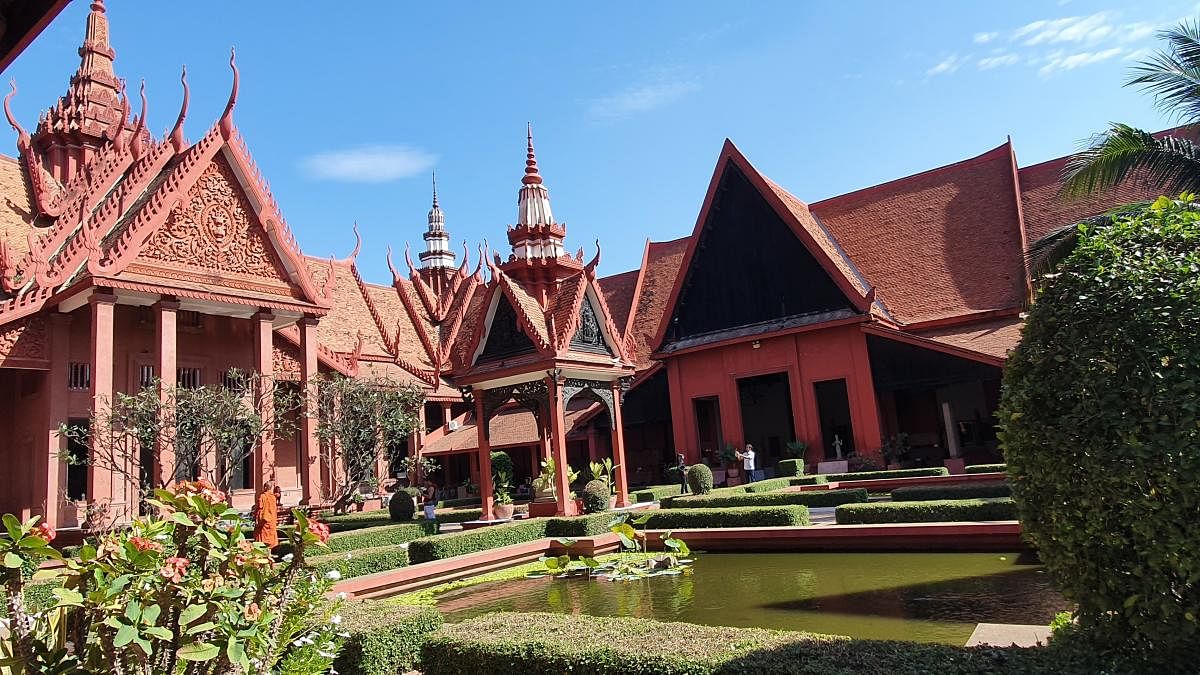

We were eager to check into our hotel following our late-night journey from Bengaluru as we sped through the congested streets of Phnom Penh in our minivan. But, anticipating a delay in check-in, we departed for an early lunch of black rice and veggies amok, which made its debut in our Khmer meal.
We started our Phnom Penh trip after a well-deserved rest and refreshment stop at the Royal Palace of Cambodia, which features the magnificent Throne Hall, museum, Silver Pagoda, Royal Stupas, and other manors amidst well-kept gardens. The palace structures’ decorative Khmer gables glittered in the early-evening light. We were shocked to find a modest temple with a metal statue of Nandi as the main god on the altar.
The majestic and serene Maitreya Buddha statue within the Royal Pagoda exuded royalty. Colourful and exquisite artwork from Reamker, the Cambodian epic based on the Ramayana, decorated the walls of the palace. We had to take our time enjoying those murals because they were so colourful and numerous. The Khmer empire of Cambodia, the prevalent Buddhism, and the cultural parallels between Cambodia and India were all being described to us by Sojata, our tour guide and a practising Buddhist. For us, witnessing so many Bajaj Maxima cars driving around Phnom Penh was a Hamara Bajaj moment. We were taken to Wat Phnom, a Buddhist temple that serves as a symbol for the city’s name, on our first tuk-tuk journey across the city.
On either side of the majestic stairway leading to the temple were enormous statues of lions, guards, and seven hooded snakes. After paying our respects to Buddha, we departed towards the following sight. We were met at Central Market’s entrance by a plethora of beautiful flowers. Arrangement towers composed of pink and white lotus flowers drew our attention. We travelled to Riverside Park where the Tonle Sap and Mekong rivers meet. The environment was lovely and vibrant, with the onset of night gradually ringing in with the cold river wind.
The following day, we set out for the Choeung Ek Genocidal Centre, a sombre memorial to the horrible atrocities against humanity performed by the Khmer Rouge dictatorship. About a million people were put to death by the Khmer Rouge in this location, known as the Killing Fields! In one location, we took the audio tour while moving silently from point to point attempting to understand the complete annihilation and horrifying horrors that took place in this once orchard. We were overcome with emotion as we approached a massive Chankiri tree known as the Killing Tree, where infants and children were slaughtered by having their heads slammed against the tree trunk. When we learned that loud revolutionary music was being played while horrors were being committed inside, it broke our hearts. This was done to give the impression that there was a celebration going on inside the locked gates of the Killing Field to the folks who lived outside. When we entered the National Memorial Stupa, we were met with almost 5,000 human skulls arranged in a glass display, each one categorised by the cause of death. This encounter silenced us in utter terror. Every second spent here was a sombre memorial to the lives that were lost. We couldn’t help but ponder in silence how, for the most part, the rest of the world had chosen to ignore these rapacious atrocities.
Our next trip was to the Tuol Sleng Genocide Museum, a former secondary school that the Khmer Rouge leadership brutally converted into a prison and detention facility. Inhumanely repressive conditions were present here where prisoners were held. The holding cages that had once been classrooms were horribly cruel. The corridors were enclosed by barbed wire to stop the convicts from committing suicide and to prevent them from escaping the torture rather than to protect the prisoners. We were horrified to see the instruments of torture that were being utilised. The images of over 20,000 detainees who were detained here never to be seen alive at all are now displayed in a number of rooms of this S-21 jail-turned-museum. We first encountered Chum Mey, one of the pitiful few survivors, in an exactly identical setting. Even though he only spoke Khmer, his humility and friendly smile betrayed the atrocities he had experienced here. We were fortunate to obtain an autographed copy of his memoir about his earlier days.
The National Museum of Cambodia, the largest in the nation and displaying Khmer artefacts from the 5th to the 12th century, welcomed us with strategically placed Khmer statues. The striking architectural parallels between the Khmer and Dravidian periods left us speechless in awe and admiration. We were able to see the trade route from South India to the former Kambhoja kingdom in detail on several ancient maps.
There were numerous complex sculptures of Garuda, Buddha, Yama, and Naga in addition to numerous Hindu gods and goddesses, all with a Khmer influence. The enormous statue of Vaali and Sugriva in a combative stance, the opulent Khmer boat, and the meditating Lord Shiva with his third eye are a few noteworthy examples. Without a doubt, this museum revives the Khmer culture, a renowned patron of the arts and architecture.